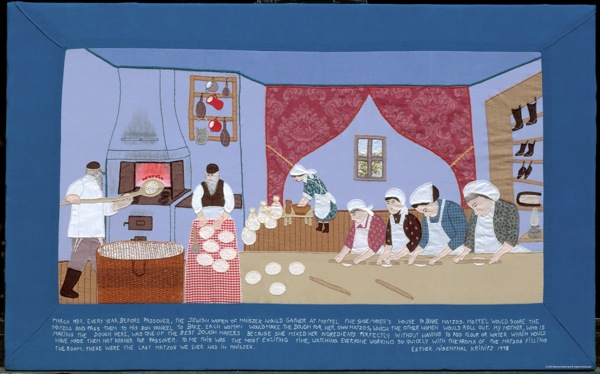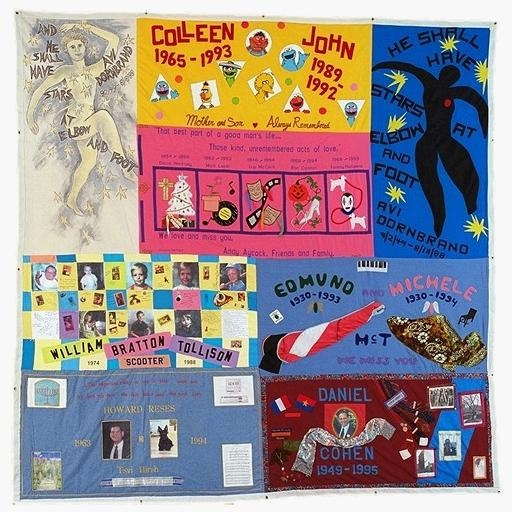
If you haven’t been to AVAM (the American Visionary Art Museum, for the uninitiated) lately, you should go — because where else can you see an entire exhibit of work by artists with Obsessive Compulsive Disorder? But seriously, in addition to the OCD exhibit there’s a great display of embroidered fabric collages by Esther Krinitz, a Polish holocaust survivor. The collages tell the story of her childhood interrupted by the Nazi occupation, how her village and her family were rounded up and taken away to their death by Nazi soldiers, and how she and her sister miraculously escaped by posing as Polish Catholics.
Krinitz started making the collages in her fifties as a way to pass her stories along to her family. She ended up making 36 fabric art pieces telling the story of her childhood, her escape from the Nazi occupation and her eventual migration to the United States. The collages show images of her idyllic village in rural Poland and the traditions of her community, like making matzoh together before Passover.
Image by Esther Krinitz, courtesy of Art and Remembrance.
The pieces are remarkable for the story they tell and for their incredible beauty and detail. Although she never studied art, Krinitz was trained as a dressmaker and her skills clearly show in the intricate embroidery. They are embellished with incredible detail, from the tiny leaves on each tree to the braids in the little girls’ hair. She took the skills she had and turned them into these beautiful pieces of art that tell a tragic and powerful story.
Krinitz’ daughters founded a nonprofit, Art and Remembrance, which “seeks to change people’s hearts and minds by illuminating the experience of war, oppression, and injustice through the power and passion of personal narrative in art.” The organization exhibits Krinitz’ pieces and helps others make fabric art about their own experiences.
Another artist who uses fabric to tell stories is Faith Ringgold. Ringgold started her career as a painter but is now known for her story quilts, which combine quilted fabric, painting and text, often illustrating themes of African-American history, racial and gender inequality. For example, her first story quilt, “Who’s Afraid of Aunt Jemima?” took on stereotypes of black women, reimagining Aunt Jemima as a feminist hero.
Ringgold’s quilts draw upon the African-American quilting tradition and her own family’s connections to sewing. Her mother was a seamstress and fashion designer, and her great-great-grandmother had learned to sew quilts as a slave. As a traditionally female activity, quilting is also an apt medium for Ringgold’s feminist messages.
The AIDS Memorial quilt is a community art project that uses the quilting medium for activism. Started in the late 80’s when there was still a lot of stigma around AIDS, a group of activists in San Francisco made the first quilt to memorialize friends and lovers and bring awareness of the devastating effect of the disease. The AIDS quilt now has more than 48,000 squares and has been displayed in thousands of cities worldwide.
Image via AIDS Services of Austin
There are even more examples, from craftivists in the UK quilting against hunger to Latina women in California making quilts about their experiences as immigrants.While most of these pieces are more art than craft, they use a craft medium that has been used for centuries to make both functional and decorative objects. Quilting is a longtime tradition, which has served as a way to socialize (i.e. quilting bees), pass on memories to family, even send clandestine messages (i.e. on the underground railroad, although the historical accuracy of that claim is debated). These contemporary quilts use a centuries-old craft to tell stories, remind us of injustices past and present and celebrate lives.


